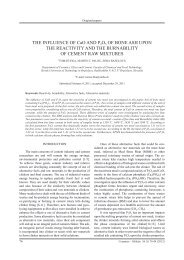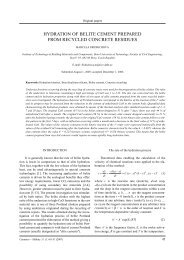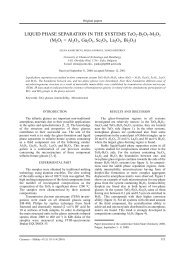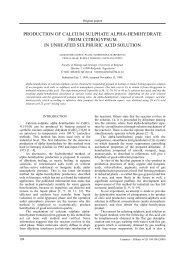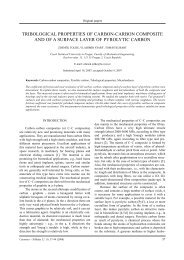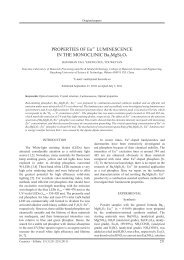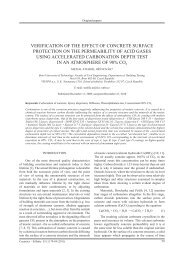behaviour of alumina-spinel self-flowing castables - Ceramics-Silikaty
behaviour of alumina-spinel self-flowing castables - Ceramics-Silikaty
behaviour of alumina-spinel self-flowing castables - Ceramics-Silikaty
Create successful ePaper yourself
Turn your PDF publications into a flip-book with our unique Google optimized e-Paper software.
Behaviour <strong>of</strong> <strong>alumina</strong>-<strong>spinel</strong> <strong>self</strong>-<strong>flowing</strong> <strong>castables</strong> with nano-<strong>alumina</strong> particles addition<br />
nano-<strong>alumina</strong> particles instead <strong>of</strong> reactive <strong>alumina</strong> in<br />
the castable composition, the packing density can be<br />
increased hence, the mechanical strength.<br />
On the other hand, this Figure shows that nano<strong>alumina</strong><br />
particles content over than 0.5 wt.% has great<br />
effect on the strength increasing at 1200°C and higher.<br />
This means that sintering <strong>of</strong> the refractory castable occu-<br />
rred in the lower temperature when nano-sized particles<br />
in the composition are increased (higher than 0.5 wt.%).<br />
Adding nano-<strong>alumina</strong> in high <strong>alumina</strong> refractory <strong>castables</strong>,<br />
the solid phase sintering <strong>of</strong> the nano-sized particles<br />
occurred in the lower temperature because <strong>of</strong> the<br />
difference <strong>of</strong> surface area and special surface area energy<br />
between the matrix particles and the nano-<strong>alumina</strong><br />
particles.<br />
Figure 5. SEM photomicrograph <strong>of</strong> <strong>alumina</strong>-<strong>spinel</strong> castable<br />
containing 4 wt.% nano-<strong>alumina</strong> particles after drying.<br />
Figure 6. SEM photomicrograph <strong>of</strong> <strong>alumina</strong>-<strong>spinel</strong> castable con-<br />
taining 4 wt.% nano-<strong>alumina</strong> particles after firing at 1500°C.<br />
Figures 5 and 6 demonstrate the microstructure <strong>of</strong><br />
<strong>alumina</strong>-<strong>spinel</strong> castable containing 4 wt.% nano-<strong>alumina</strong><br />
particles after drying and after firing at 1500°C. Figure<br />
5 shows high packing microstructure, in which the finer<br />
particles occupy the voids between the coarser particles,<br />
enabling a decrease in the porosity and increase <strong>of</strong> the<br />
density and mechanical strength. It can be seen from<br />
Figure 6 that fine particles in the matrix has grown as<br />
flake shape and interlocked. This led to increasing <strong>of</strong><br />
strength at high temperatures. When the nano-<strong>alumina</strong><br />
particles come into contact with the matrix in the process<br />
<strong>of</strong> sintering, the transference will happen from<br />
nano-sized and fine particles to big particles because <strong>of</strong><br />
the difference <strong>of</strong> curvature radius. In this process, the<br />
particles coursing occurred, which made the surface<br />
energy decreased.<br />
CONCLUSIONS<br />
This study confirmed the strong influence that<br />
extremely fine <strong>alumina</strong> particles exert on the properties<br />
<strong>of</strong> <strong>self</strong>-<strong>flowing</strong> <strong>alumina</strong>-<strong>spinel</strong> <strong>castables</strong>. An attraction<br />
between nano-<strong>alumina</strong> particles and other fine particles<br />
in the castable matrix appears to promote lower flow<br />
ability in this system. Also, the addition <strong>of</strong> nano-<strong>alumina</strong><br />
particles in the castable composition decrease working<br />
time. The results also indicate that the nano-<strong>alumina</strong><br />
particles have a great effect on the green and firing<br />
strength <strong>of</strong> these <strong>castables</strong>. Adding nano-<strong>alumina</strong> in <strong>alumina</strong>-<strong>spinel</strong><br />
castable, the solid phase sintering <strong>of</strong> the<br />
nano-sized particles occurred in the lower temperature<br />
because <strong>of</strong> the difference <strong>of</strong> surface area energy between<br />
the matrix and the nano-<strong>alumina</strong> particles. The best results<br />
are obtained with 1.5 wt.% nano-<strong>alumina</strong> addition which<br />
defines the <strong>self</strong>-<strong>flowing</strong> castable with sufficient working<br />
time and high mechanical strength.<br />
References<br />
1. Mukhpadhyay S., Pal P., Nag B., Jana P.: <strong>Ceramics</strong><br />
International 33, 175 (2007).<br />
2. Janeway P.: Am. Ceram. Soc. Bull. 82, 31 (2003).<br />
3. Ko Y. C.: Ceramic News Special Refractories 6, 51 (2002).<br />
4. de Sousa Resende W.: Ceramic News Special Refractories<br />
6, 57 (2002).<br />
5. Otroj S., Marzban R., Adibi M. B., Nikoo K. A.: Proc.<br />
48 th International Colloquium on Refractories, p.52-55,<br />
Eurogress Aachen 2005.<br />
6. ASTM-C 1446-99: Standard Method for Measuring Consistency<br />
& Working Time <strong>of</strong> Self-Flowing Castable Refractories.<br />
<strong>Ceramics</strong> – Silikáty 53 (2) 98-101 (2009) 101



